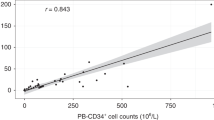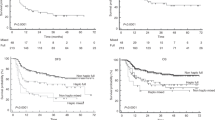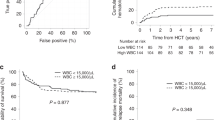Abstract
We examined pre-mobilization blood CD34+ cell count to predict ability to mobilize adequate peripheral blood progenitor cells (PBPC) in 106 cancer patients and 36 allogeneic donors. Mean pre-mobilization therapy blood CD34+ cell count was 3.1 cells × 106/l (s.d.=3.9, r=0.3–37) and mean CD34+ cells collected were 5.3 × 106 cells/kg/leukapheresis procedure (s.d.=7.0, r=0.03–53). Yields correlated with pre-mobilization CD34+ cells × 106/l (r=0.37, P-value<0.0001); correlation was stronger in allogeneic donors (r=0.56, P-value=0.0004) and males (r=0.46, P-value<0.0001). Based on classification and regression tree multivariate analysis, the predictive value of pre-mobilization blood CD34+ cell count was confounded by other variables, including age, gender, mobilization regimen and malignancy type. We generated an algorithm to predict a minimum PBPC yield of 1 × 106 CD34+ cells/kg/leukapheresis procedure after mobilization. A threshold pre-mobilization blood CD34+ cell count of 2.65 cells × 106/l was the most important decision point in predicting successful mobilization. Only 2% of subjects with pre-mobilization blood CD34+ cell counts >2.65 cells × 106/l did not achieve the minimum per apheresis, whereas 24% with pre-mobilization values below threshold had inadequate mobilization. Prospectively identifying individuals at risk for mobilization failure would allow for improved treatment planning, resource utilization and time saving.
This is a preview of subscription content, access via your institution
Access options
Subscribe to this journal
Receive 12 print issues and online access
$259.00 per year
only $21.58 per issue
Buy this article
- Purchase on Springer Link
- Instant access to full article PDF
Prices may be subject to local taxes which are calculated during checkout



Similar content being viewed by others
References
Stem Cell Trialists' Collaborative Group. Allogeneic peripheral blood stem-cell compared with bone marrow transplantation in the management of hematologic malignancies: an individual patient data meta-analysis of nine randomized trials. J Clin Oncol 2005; 23: 5074–5087.
Kettereer N, Salles G, Moullet I, Dumontet C, ElJaafari-Corbin A, Tremisi P et al. Factors associated with successful mobilization of peripheral blood progenitor cells in 200 patients with lymphoid malignancies. Br J Haematol 1998; 103: 235–242.
Demirer T, Buckner CD, Gooley T, Appelbaum FR, Rowley S, Chauncey T et al. Factors influencing collection of peripheral blood stem cells in patients with multiple myeloma. Bone Marrow Transplant 1996; 17: 937–941.
Weaver CH, Hazelton B, Birch R, Palmer P, Allen C, Schwartzberg L et al. An analysis of engraftment kinetics as a function of the CD34 content of peripheral blood progenitor cell collections in 692 patients after the administration of myeloablative chemotherapy. Blood 1995; 86: 3961–3969.
Bensinger W, Appelabum F, Rowley S, Storb R, Sanders J, Lilleby K et al. Factors that influence collection and engraftment of autologous peripheral-blood stem cells. J Clin Oncol 1995; 13: 2547–2555.
Demirer T, Buckner CD, Storer B, Lilleby K, Rowley S, Clift R et al. Effect of different chemotherapy regimens on peripheral-blood stem-cell collections in patients with breast cancer receiving granulocyte colony-stimulating factor. J Clin Oncol 1997; 15: 684–690.
Watts MJ, Ings SJ, Flynn M, Dodds D, Goldstone AH, Linch DC et al. Remobilization of patients who fail to achieve minimal progenitor thresholds at the first attempt is clinically worthwhile. Br J Haematol 2000; 111: 287–291.
Sugrue MW, Williams K, Pollock BH, Khan S, Peracha S, Wingard JR et al. Characterization and outcome of ‘hard to mobilize’ lymphoma patients undergoing autologous stem cell transplantation. Leukemia Lymphoma 2000; 39: 509–519.
Stockerl-Goldstein KE, Reddy SA, Horning SF, Blume KG, Chao NF, Hu WW et al. Favorable treatment outcome in non-Hodgkin's lymphoma patients with ‘poor’ mobilization of peripheral blood progenitor cells. Biol Blood Marrow Transplant 2000; 6: 506–512.
Perry AR, Watts MJ, Peniket AH, Goldstone AH, Linch DC . Progenitor cell yields are frequently poor in patients with histologically indolent lymphomas especially when mobilized within 6 months of previous chemotherapy. Bone Marrow Transplant 1998; 21: 1201–1205.
Clark RE, Brammer CG . Previous treatment predicts the efficiency of blood progenitor cell mobilization: validation of a chemotherapy scoring system. Bone Marrow Transplant 1998; 22: 859–863.
Stiff PJ . Management strategies for the hard-to-mobilize patient. Bone Marrow Transplant 1999; 23 (Suppl 2): S29–S33.
Corringham RE, Ho AD . Rapid and sustained allogeneic transplantation using immunoselected CD34+-selected peripheral blood progenitor cells mobilized by recombinant granulocyte and granulocyte-macrophage colony-stimulating factors. Blood 1995; 86: 2052–2054.
Gratama JW, Orfao A, Barnett D, Brando B, Huber A, Janossy G et al. Flow cytometric enumeration of CD34+ hematopoietic stem and progenitor cells. European Working Group on Clinical Cell Analysis. Cytometry 1998; 34: 128–142.
Sandhaus LM, Edinger MG, Tubbs RR, Goormastic M, Baucco PA, Serafino SE et al. A simplified method of CD34+ cell determination for peripheral blood progenitor cell transplantation and correlation with clinical engraftment. Exp Hematol 1998; 26: 73–78.
Breiman L, Friedman JH, Olshen RA, Stone CJ . Classification and Regression Trees. Chapman & Hall (Wadsworth Inc.): New York, 1984.
Venables WM, Ripley BD . Modern Applied Statistics with S-plus, 3rd edn. Springer-Verlag: Berlin, 1999.
McCullagh P, Nelder JA . Generalized Linear Models. Chapman & Hall: London, 1989.
Singhal S, Powles R, Treleaven J, Kulkarni S, Sirohi B, Horton C et al. A low CD34+ cell dose results in higher mortality and poorer survival after blood or marrow stem cell transplantation from HLA-identical siblings: should 2 × 106 CD34+ cells/kg be considered the minimum threshold? Bone Marrow Transplant 2000; 26: 489–496.
Watts MJ, Sullivan AM, Leverett D, Peniket AJ, Perry AR, Williams CD et al. Back-up bone marrow is frequently ineffective in patients with poor peripheral-blood stem-cell mobilization. J Clin Oncol 1998; 16: 1554–1560.
Goterris R, Hernandez-Boluda JC, Teruel A, Gomez C, Lis MJ, Terol MJ et al. Impact of different strategies of second-line stem cell harvest on the outcome of autologous transplantation in poor peripheral blood stem cell mobilizers. Bone Marrow Transplant 2005; 36: 847–853.
Boeve S, Strupeck J, Creech S, Stiff PJ . Analysis of remobilization success in patients undergoing autologous stem cell transplants who fail an initial mobilization: risk factors, cytokine use and cost. Bone Marrow Transplant 2004; 33: 997–1003.
Perea G, Sureda A, Martino R, Altes A, Martinez C, Cabezudo E et al. Predictive factors for a successful mobilization of peripheral blood CD34+ cells in multiple myeloma. Ann Hematol 2001; 80: 592–597.
Canales MA, Fernandez-Jimenez MC, Martin A, Arrieta R, Caballero MD, Diez J et al. Identification of factors associated with poor peripheral blood progenitor cell mobilization in Hodgkin's disease. Haematologica 2001; 86: 494–498.
D'Arena G, Musto P, Di Mauro L, Cascavilla N, Iacono ND, Scalzulli PR et al. Predictive parameters for mobilized peripheral blood CD34+ progenitor cell collection in patients with hematological malignancies. Am J Hematol 1998; 58: 255–262.
Sautois B, Fraipont V, Baudoux E, Fassotte MF, Hermanne JP, Jerusalem G et al. Peripheral blood progenitor cell collections in cancer patients: analysis of factors affecting the yields. Haematologica 1999; 84: 342–349.
Schlenk RF, Dohner H, Pforsich M, Benner A, Fischer K, Hartmann F et al. Successful collection of peripheral blood progenitor cells in patients with acute myeloid leukaemia following early consolidation therapy with granulocyte colony-stimulating factor-supported high-dose cytarabine and mitoxantrone. Br J Haematol 1997; 99: 386–393.
Tarella C, Zallio F, Caracciolo D, Cherasco C, Bondesan P, Gavarotti P et al. Hemopoietic progenitor cell mobilization and harvest following an intensive chemotherapy debulking in indolent lymphoma patients. Stem Cells 1999; 17: 55–61.
Marit G, Thiessard F, Faberes C, Cony-Makhoul P, Boiron JM, Bernard P et al. Factors affecting both peripheral blood progenitor cell mobilization and hematopoietic recovery following autologous blood progenitor cell transplantation in multiple myeloma patients: a monocentric study. Leukemia 1998; 12: 1447–1456.
Watts MJ, Sullivan AM, Jamieson E, Pearce R, Fielding A, Devereux S et al. Progenitor cell mobilization after low-dose cyclophosphamide and granulocyte colony-stimulating factor: an analysis of progenitor-cell quantity and quality and factors predicting for these parameters in 101 pretreated patients with malignant lymphoma. J Clin Oncol 1997; 15: 535–546.
Boccadoro M, Palumbo A, Bringhen S, Merletti F, Ciccone G, Richiardi L et al. Oral melphalan at diagnosis hampers adequate collection of peripheral blood progenitor cells in multiple myeloma. Haematologica 2002; 87: 846–850.
Tournilhac O, Cazin B, Lepretre S, Divine M, Maloum K, Delmer A et al. Fludarabine plus cyclophosphamide as front line therapy in chronic lymphocytic leukemia (CLL) durably impairs steady state G-CSF peripheral blood progenitor cell (PBPC) mobilization and harvest. Blood 2002; 100: 827a (abstract 3267).
Ashihara E, Shimazaki C, Uchiyama H, Inaba T, Uchida R, Fuchida S et al. Predictive parameters for the G-CSF-induced PBSC mobilization. Blood 2002; 100: 414b (abstract 5222).
Husson B, Ravoet C, Dehon M, Wallef G, Hougardy N, Delannoy A . Predictive value of the steady-state peripheral blood progenitor cell (PBPC) counts for the yield of PBPC collected by leukapheresis after mobilization by granulocyte colony-stimulating factor (G-CSF) alone or chemotherapy and G-CSF. Blood 1996; 87: 3526–3528.
Fruehauf S, Schmitt K, Veldwijk MR, Topaly J, Benner A, Zeller WJ et al. Peripheral blood progenitor cell (PBPC) counts during steady-state haemopoiesis enable the estimation of the yield of mobilized PBPC after granulocyte colony-stimulating factor supported cytotoxic chemotherapy: an update on 100 patients. Br J Haematol 1999; 105: 786–794.
Liles WC, Rodger E, Broxmeyer HE, Srour EF, Dehner C, Badel K et al. Mobilization and collection of CD34+ progenitor cells from normal human volunteers with AMD-3100, a CXCR4 antagonist, and G-CSF. Blood 2002; 100: 109a (abstract 404).
Flomenberg N, Devine SM, Dipersio JF, Liesveld JL, McCarty JM, Rowley SD et al. The use of AMD3100 plus G-CSF for autologous hematopoietic progenitor cell mobilization is superior to G-CSF alone. Blood 2005; 106: 1867–1874.
Carlo-Stella C, Di Nicola M, Mialani R, Guidetti A, Magni M, Milanesi M et al. Use of recombinant human growth hormone (rhGH) plus recombinant human granulocyte colony-stimulating factor (rhG-CSF) for the mobilization and collection of CD34+ cells in poor mobilizers. Blood 2004; 103: 3287–3295.
Author information
Authors and Affiliations
Corresponding author
Rights and permissions
About this article
Cite this article
Fu, P., Bagai, R., Meyerson, H. et al. Pre-mobilization therapy blood CD34+ cell count predicts the likelihood of successful hematopoietic stem cell mobilization. Bone Marrow Transplant 38, 189–196 (2006). https://doi.org/10.1038/sj.bmt.1705431
Received:
Revised:
Accepted:
Published:
Issue Date:
DOI: https://doi.org/10.1038/sj.bmt.1705431
Keywords
This article is cited by
-
Proposed definition of ‘poor mobilizer’ in lymphoma and multiple myeloma: an analytic hierarchy process by ad hoc working group Gruppo ItalianoTrapianto di Midollo Osseo
Bone Marrow Transplantation (2012)
-
Targeting the stem cell niche: squeezing blood from bones
Bone Marrow Transplantation (2007)



